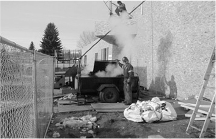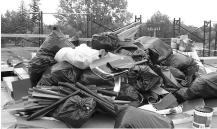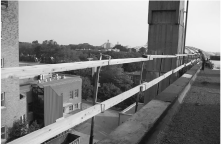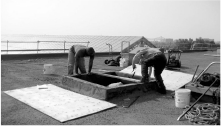Safety on a worksite begins when you first arrive to set-up. Proper planning and set-up will help eliminate possible hazards. Remember, you are responsible not only for your own protection, but that of your fellow workers and the public.
The following are general work site safety rules that should be followed:
- Set up warning signs and barricades around entire work area. Barricade off the kettle and hoisting area.
- Keep all traffic areas clear and open.
 Find a good location for the roofing operation and equipment setup. The ground should be firm, level and free of construction materials or debris. On sloped ground or roof decks, block material and equipment wheels to prevent them from rolling.
Find a good location for the roofing operation and equipment setup. The ground should be firm, level and free of construction materials or debris. On sloped ground or roof decks, block material and equipment wheels to prevent them from rolling.- Avoid excavations, trenches or power lines.
- Use proper lifting techniques to unload equipment and materials.
- Keep the hoisting path clear of overhead wires or obstructions.
- Never overload hoists.
- Always have a first aid kit on site as required by OH&S.
- Ensure that the correct number of fire extinguishers are on site and in their required locations. Always have at least one ABC fire extinguisher near the kettle and one on the roof for each working torch.
- Locate equipment where fumes and dust will not be drawn into the building through fresh air intakes or openings.
- Coordinate activities with other trades.
- Do not block access areas or doorways without approval.
- Erect signs at ground level to alert pedestrians to the danger above.
- Store all roofing materials away from the immediate work area. This will help avoid repeated and unnecessary handling.
 Maintain a clean job site. Where scraps and discarded pieces are in the way, work is slowed down. Dispose of trash, wrappers, and other refuse that pose a fire hazard immediately or confine them to a clearly marked refuse area. Pick up debris whenever you see it. After each day’s work, clean up the entire working area.
Maintain a clean job site. Where scraps and discarded pieces are in the way, work is slowed down. Dispose of trash, wrappers, and other refuse that pose a fire hazard immediately or confine them to a clearly marked refuse area. Pick up debris whenever you see it. After each day’s work, clean up the entire working area.- Keep any waste material well away from the kettle and work area and in a container.
- Keep all kettles and asphalt heating equipment clean.
- Clean equipment regularly. Mop handles and the outside of bitumen buckets, particularly the handle, should be kept clean. Use a knife to scrape off materials. Clean other equipment with the appropriate solvent, but only in a well-ventilated area free from any sources of ignition.
- Protect all finished walls and adjacent surfaces with adequate tarps or coverings.
- Dispose of all roof waste properly. Do not throw waste off the roof to the ground below. Keep a waste container on the roof that can be emptied daily.
- At the end of each day, all equipment and materials must be collected before the crew leaves the job. Cover all motors and materials to protect them from moisture. Secure the spigot and lid of the kettle at night; Close all lids and covers on the kettle and turn over all hot carriers so as to prevent accumulation of moisture and bitumen build-up. Remove the propane cylinder hand wheels. Remove ladders from the job site or lock ladders in a horizontal position to prevent access to the roof. Secure trucks, hoists and other equipment.
- Always use CSA approved containers for storing flammable materials.
- Be especially careful when handling material near the roof edge.
- Never place material or equipment within 2 m (6½ ft) from an unguarded roof edge.
- Ensure equipment is in good working order and all protective guards are installed.
- Ensure that all electrical tools are grounded and cords are in good condition.
- When handling hot asphalt bitumen, always be aware of your fellow workers.
- Materials must be neatly stacked and placed out of the way. Tools and equipment should be put away after use and not stored near the edge of the roof.
- The area around the kettle can be particularly hazardous. A good kettle operator will always neatly fold and stack tins, pick up debris, keep the materials neatly stacked and organized, and see that propane cylinders are tied upright.
Roof Deck
When you first get on to the roof it is important to identify all potentially hazardous conditions.
 Inspect the roof deck before getting on it to make sure that it is strong enough to support the crew and material, roof deck edges are supported and ensure proper placement of material on the deck. Take extra precautions when roofing over lightweight steel or wood decks and modular cementitious panel decks.
Inspect the roof deck before getting on it to make sure that it is strong enough to support the crew and material, roof deck edges are supported and ensure proper placement of material on the deck. Take extra precautions when roofing over lightweight steel or wood decks and modular cementitious panel decks.- Ensure that barricades and fall protection are installed around work area, including parapet and any openings where falling is a hazard. Openings with a flashing curb can be covered and secured with plywood if the opening is small. Large openings can be either covered and secured with plywood or barricaded by a guard rail around the opening. For large openings that cannot be covered adequately, install guard rails. On new construction, guardrails are usually the responsibility of the general contractor and should be installed before the roofers set up.
- Check for problems in the roof deck itself. On reroofing projects look out for decayed wood, rusted or corroded steel decks or deteriorated concrete. On steel decks, locations of gas or infrared heating units and overhead doors are particularly susceptible to rusting due to condensation. On new construction, make sure the deck is securely fastened to the joists or purlins.
 Make sure the roof perimeter and all openings are reinforced under the deck.
Make sure the roof perimeter and all openings are reinforced under the deck.- Deck openings present a fall hazard, either by tripping over them or falling right through. Never begin any work on the roof until the openings and parapets are covered or barricaded. Small holes for pipe penetrations or duct work can be covered with plywood that is secured to the deck to prevent displacement.
- Repairs to the roof deck may be required before the roof membrane can be applied. A poorly fastened, weak or damaged deck is a hazard if a roofer steps on a corner or edge of a sheet and breaks through.
- If the roof is covered with ice, snow or frost exercise extreme caution. You may need to clear the roof in order to proceed with work.
